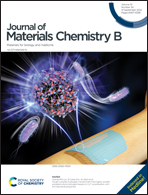Hydrophilic glutathione-modified flower-like hollow covalent organic frameworks for highly efficient capture of N-linked glycopeptides†
Abstract
Highly efficient enrichment of N-glycopeptides from complicated biosamples based on mass spectrometry is essential for biomedical applications, especially in disease biomarker research. In this work, glutathione (GSH)-modified hierarchical flower-like hollow covalent organic frameworks loaded with Au nanoparticles (HFH-COFs@Au@GSH) were synthesized for N-glycopeptide enrichment. Due to the abundant accessibility sites, high specific surface area, and inherent high stability of the hierarchical flower-like hollow structure, a large number of Au NPs and hydrophilic GSH can be modified on the HFH-COFs. The HFH-COFs@Au@GSH displayed excellent hydrophilicity and remarkable enrichment performance for N-glycopeptides: low detection limit (0.1 fmol μL−1), large adsorption capacity (200 μg mg−1), great selectivity (1 : 1000, HRP to BSA), and good reusability (at least 5 times). Furthermore, the HFH-COFs@Au@GSH were successfully applied to capture N-linked glycopeptides in human serum, and 308 N-glycosylation peptides corresponding to 84 N-glycosylation proteins with 123 N-glycosylation sites were detected. Gene ontology analyses were used to elucidate the cellular component, biological process and molecular function of detected glycoproteins in human serum, demonstrating the great potential of the HFH-COFs@Au@GSH in N-glycopeptide enrichment for glycoproteomic analysis of complex biological samples.



 Please wait while we load your content...
Please wait while we load your content...